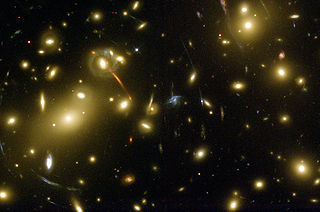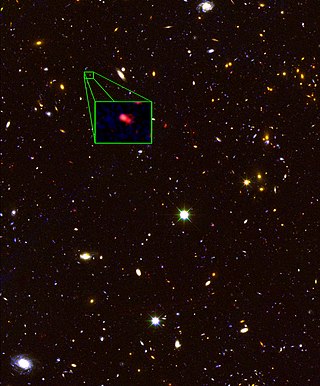
A quasar is an extremely luminous active galactic nucleus (AGN). It is sometimes known as a quasi-stellar object, abbreviated QSO. The emission from an AGN is powered by a supermassive black hole with a mass ranging from millions to tens of billions of solar masses, surrounded by a gaseous accretion disc. Gas in the disc falling towards the black hole heats up and releases energy in the form of electromagnetic radiation. The radiant energy of quasars is enormous; the most powerful quasars have luminosities thousands of times greater than that of a galaxy such as the Milky Way. Quasars are usually categorized as a subclass of the more general category of AGN. The redshifts of quasars are of cosmological origin.

In physics, a redshift is an increase in the wavelength, and corresponding decrease in the frequency and photon energy, of electromagnetic radiation. The opposite change, a decrease in wavelength and increase in frequency and energy, is known as a blueshift, or negative redshift. The terms derive from the colours red and blue which form the extremes of the visible light spectrum. The main causes of electromagnetic redshift in astronomy and cosmology are the relative motions of radiation sources, which give rise to the relativistic Doppler effect, and gravitational potentials, which gravitationally redshift escaping radiation. All sufficiently distant light sources show cosmological redshift corresponding to recession speeds proportional to their distances from Earth, a fact known as Hubble's law that implies the universe is expanding.

A supercluster is a large group of smaller galaxy clusters or galaxy groups; they are among the largest known structures in the universe. The Milky Way is part of the Local Group galaxy group, which in turn is part of the Virgo Supercluster, which is part of the Laniakea Supercluster, which is part of the Pisces–Cetus Supercluster Complex. The large size and low density of superclusters means that they, unlike clusters, expand with the Hubble expansion. The number of superclusters in the observable universe is estimated to be 10 million.

Abell 2218 is a large cluster of galaxies over 2 billion light-years away in the constellation Draco.

Abell 1835 IR1916 was a candidate for being the most distant galaxy ever observed, although that claim has not been verified by additional observations. It was claimed to lie behind the galaxy cluster Abell 1835, in the Virgo constellation.
Rychard J. Bouwens is an associate professor at Leiden University. He is also a former member of the Advanced Camera for Surveys Guaranteed Time Observation team and postdoctoral research astronomer at the University of California, Santa Cruz. He obtained his bachelor's degree in physics, chemistry, and mathematics from Hope College. He then went on to earn his Ph.D. in physics at the University of California, Berkeley under the supervision of Joseph Silk and also worked with Tom Broadhurst.

HCM-6A is an LAE galaxy that was found in 2002 by Esther Hu and Lennox Cowie from the University of Hawaii and Richard McMahon from the University of Cambridge, using the Keck II Telescope in Hawaii. HCM-6A is located behind the Abell 370 galactic cluster, near M77 in the constellation Cetus, which enabled the astronomers to use Abell 370 as a gravitational lens to get a clearer image of the object.

A1689-zD1 is a galaxy in the Virgo constellation. It was a candidate for the most distant and therefore earliest-observed galaxy discovered as of February 2008, based on a photometric redshift.

GRB 090423 was a gamma-ray burst (GRB) detected by the Swift Gamma-Ray Burst Mission on April 23, 2009, at 07:55:19 UTC whose afterglow was detected in the infrared and enabled astronomers to determine that its redshift is z = 8.2, making it one of the most distant objects detected at that time with a spectroscopic redshift.
GRB 000131 was a gamma-ray burst (GRB) that was detected on 31 January 2000 at 14:59 UTC. A gamma-ray burst is a highly luminous flash associated with an explosion in a distant galaxy and producing gamma rays, the most energetic form of electromagnetic radiation, and often followed by a longer-lived "afterglow" emitted at longer wavelengths.

UDFy-38135539 is the Hubble Ultra Deep Field (UDF) identifier for a galaxy which was calculated as of October 2010 to have a light travel time of 13.1 billion years with a present proper distance of around 30 billion light-years.

UDFj-39546284 is a high-redshift Lyman-break galaxy discovered by the Hubble Space Telescope in infrared Hubble Ultra-Deep Field (HUDF) observations in 2009. The object, located in the Fornax constellation, was identified by G. Illingworth, R. Bouwens and the HUDF09 Team during 2009 and 2010. It was reported with a redshift of z~10 using Hubble and Spitzer Space Telescope photometric data, with later reports in 2012 suggesting a possibly higher redshift of z = 11.9 Although doubts were raised that this galaxy could instead be a low-redshift interloper with extreme spectral emission lines producing the appearance of a very high redshift source, later spectroscopic observations by the James Webb Space Telescope's NIRSpec instrument in 2022 confirmed the galaxy's high redshift to a spectroscopically confirmed estimate of z = 11.58.

MACS1149-JD1 is one of the farthest known galaxies from Earth. The galaxy was discovered in 2014, and confirmed in 2018. The JD1 galaxy is at a redshift of about z=9.11, or about 13.28 billion ly (4.07 billion pc) away from Earth.

z8_GND_5296 is a dwarf galaxy discovered in October 2013 which has the highest redshift that has been confirmed through the Lyman-alpha emission line of hydrogen, placing it among the oldest and most distant known galaxies at approximately 13.1 billion light-years (4.0 Gpc) from Earth. It is "seen as it was at a time just 700 million years after the Big Bang [...] when the universe was only about 5 percent of its current age of 13.8 billion years". The galaxy is at a redshift of 7.51, and it is a neighbour to what was announced then as the second-most distant galaxy with a redshift of 7.2. The galaxy in its observable timeframe was producing stars at a phenomenal rate, equivalent in mass to about 330 Suns per year.
Tomonori Totani is a Japanese astronomer, professor at University of Tokyo. He is a director of FastSound Project at Subaru Telescope, Hawaii. He specializes in cosmology, galaxy formation, and high-energy astrophysics.

JADES-GS-z13-0 is a high-redshift Lyman-break galaxy discovered by the James Webb Space Telescope (JWST) during NIRCam imaging for the JWST Advanced Deep Extragalactic Survey (JADES) on 29 September 2022. Spectroscopic observations by JWST's NIRSpec instrument in October 2022 confirmed the galaxy's redshift of z = 13.2 to a high accuracy, establishing it as the oldest and most distant spectroscopically-confirmed galaxy known as of 2023, with a light-travel distance of 13.4 billion years. Due to the expansion of the universe, its present proper distance is 33.6 billion light-years.













